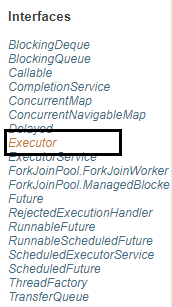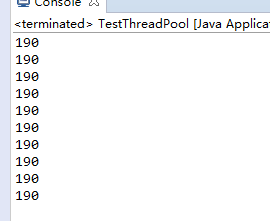线程池
第四种获取线程的方法:线程池,一个 ExecutorService,它使用可能的几个池线程之
一执行每个提交的任务,通常使用 Executors 工厂方法配置。
线程池可以解决两个不同问题:由于减少了每个任务调用的开销,它们通常可以在
执行大量异步任务时提供增强的性能,并且还可以提供绑定和管理资源(包括执行
任务集时使用的线程)的方法。每个 ThreadPoolExecutor 还维护着一些基本的统计数
据,如完成的任务数。
为了便于跨大量上下文使用,此类提供了很多可调整的参数和扩展钩子 (hook)。但
是,强烈建议程序员使用较为方便的 Executors 工厂方法 :
Executors.newCachedThreadPool()(无界线程池,可以进行自动线程回收)
Executors.newFixedThreadPool(int)(固定大小线程池)
Executors.newSingleThreadExecutor()(单个后台线程)
它们均为大多数使用场景预定义了设置
线程池:
提供了一个线程队列,队列中保存着等待状态的线程
避免了创建和销毁,提高了响应速度


线程池的体系结构
java.util.concurrent.Excutor:负责线程的使用与调度的根接口
--ExecutorService子接口:线程池的主要接口
--ThreadPoolExecutor:线程池的实现类
--ScheduleExecutorService:子接口:负责线程的调度
--ScheduleThreadPoolExecutor:继承了ThreadPoolExecutor实现类ScheduleExecutorService接口
工具类:Executors
ExecutorService newFixedThreadPool():创建固定大小的线程池
ExecutorService newCacheThreadPool():缓存线程池,线程池的数量不固定,可以根据需求修改数量
ExecutorService newSingleThreadEcecutor():创建单个的线程池,线程池中只有一个线程
ScheduleExecutorService newScheduledThreadPool():创建固定大小的线程,可以延迟或定时的执行任务
1、实现Runnable接口
class ThreadDemos implements Runnable{ private int i =0; @Override public void run() { while(i <20){ System.out.println( Thread.currentThread().getName() + ":" + i++); } } }
public static void main(String[] args) { //1创建一个线程池,5个线程 ExecutorService pool = Executors.newFixedThreadPool(5); ThreadDemos td = new ThreadDemos(); //2、为线程池中的线程分配任务 //pool.submit(td); for(int i = 0; i <10;i++){ pool.submit(td); } //3、关闭线程池 pool.shutdown(); }
结果:
pool-1-thread-1:0 pool-1-thread-5:3 pool-1-thread-5:5 pool-1-thread-5:6 pool-1-thread-4:2 pool-1-thread-2:1 pool-1-thread-3:0 pool-1-thread-2:9 pool-1-thread-2:11 pool-1-thread-2:12 pool-1-thread-2:13 pool-1-thread-4:8 pool-1-thread-5:7 pool-1-thread-1:4 pool-1-thread-5:16 pool-1-thread-4:15 pool-1-thread-2:14 pool-1-thread-3:10 pool-1-thread-4:19 pool-1-thread-5:18 pool-1-thread-1:17
此时的线程池中最多就创建了5个线程
2、Callable
public class TestThreadPool { public static void main(String[] args) throws InterruptedException, ExecutionException { //1创建一个线程池,5个线程 ExecutorService pool = Executors.newFixedThreadPool(5); List<Future<Integer>> list = new ArrayList<>(); for(int i = 0;i<10;i++){ //使用匿名内部类进行创建 Future<Integer> f = pool.submit(new Callable<Integer>() { @Override public Integer call() throws Exception { int sum = 0; for(int i = 0 ;i < 20;i++){ sum +=i; } return sum; } }); list.add(f); } //关闭 pool.shutdown(); for(Future<Integer> future:list){ System.out.println(future.get()); } } }
遍历结果:

线程调度
ScheduleExecutorService newScheduledThreadPool():创建固定大小的线程,可以延迟或定时的执行任务
ScheduledExecutorService
一个 ExecutorService,可安排在给定的延迟后运行或定期执行的命令
代码展示
public class TestScheduledThreadPool { public static void main(String[] args) throws InterruptedException, ExecutionException { //1、创建线程池 ScheduledExecutorService pool = Executors.newScheduledThreadPool(5); //2、 for(int i=0;i<=20;i++){ // public ScheduledFuture<?> schedule(Runnable command, // long delay, TimeUnit unit); //参数1:为线程池分配任务 //参数2:延时 //参数3:延时的类型 Future<Integer> f = pool.schedule(new Callable<Integer>() { @Override public Integer call() throws Exception { int number = new Random().nextInt(100); System.out.println(Thread.currentThread().getName() + ":" + number); return number; } }, 3, TimeUnit.SECONDS); System.out.println(f.get()); } /关闭 pool.shutdown(); } }
此时是3s进行一个打印输出
